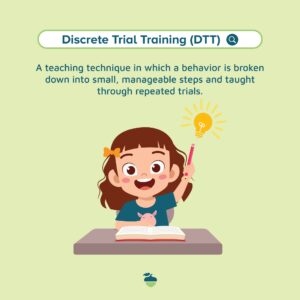Clinically reviewed by Claire Ellis, M.S., BCBA, LBA, National Director of Training & Development.
Learn more about these common terms you’ll likely hear during ABA therapy
ABA Terminology
Has your child recently started ABA therapy? Or, did your child recently receive an autism diagnosis? As you seek out resources to help your family down this path, you may start to hear new terms that are foreign to you, making meetings with specialists confusing or possibly even frustrating. Your team at Acorn Health has put together a list of the top 10 terms used in ABA, with simple definitions to explain what they mean. Now, during your next meeting with an ABA therapist, you’ll have a better understanding of what to expect.
What is Autism Spectrum Disorder (ASD)?

ABA Terms, Language and Techniques
Antecedent: the event, action, or circumstance that occur immediately before a behavior. Antecedents are important aspects for your BCBA’s to recognize and observe to better understand your child’s behaviors.
Behavior: in ABA therapy the term behavior specifically refers to any action that can be observed and measured.
Consequence: in ABA therapy, consequence is anything that happens directly after a behavior occurs. This can be good, bad, or neutral. These events help your BCBA determine the possible function of the behavior.
Functional Behavior Assessment: this refers to the process used to find and define target behaviors and their possible functions. There are three main parts to the FBA process:
- Gathering information (caregiver interviews)
- Direct observations (data collection)
- Creating a plan of action
Behavior Intervention Plan: a written improvement plan to identity problem behaviors in students with autism. BIP takes the results from the FBA and turns it into a plan of action. Some key components of a BIP include:
- Target behavior definitions
- Hypothesized functions
- Medical Necessity
- Prevention strategies
- Consequence strategies
- Client goals
- Caregiver goals
Functional Communication: a therapy for autistic children that usually involves teaching the child to obtain the same outcomes in the same contexts with another, more effective, safer behavior. This is called functional communication training or FCT.
Positive Reinforcement: the process of identifying and rewarding positive behaviors in hopes of the child repeating them. This is anything added that increases a targeted behavior. Reinforcement will differ with every child and should be reviewed frequently throughout treatment.
Pairing: this is the process of building rapport by “pairing” oneself with the child’s favorite items and activities. Through these repeated connections, we take on the reinforcing value of all the good stuff, leading to better outcomes in therapy.
Mand: A verbal behavioral request to fulfill a want or need. Manding is one of the first forms of communication naturally acquired.
Tact: A label for something the speaker sees, hears, smells, or tastes. Tact is an important skill used to dissect language for communication.
Bonus ABA Terms and Examples
Discrete Trial Training: DTT is an ABA technique breaks certain skills down into smaller components that are more easily digestible. This is a common way for teachers to articulate concepts to autistic children more effectively. For example, instead of training a child on colors they would start with a specific color like red or blue.

HOH Prompting: although it’s a tactic that should eventually be faded out, hand over hand prompting is a useful way to teach young children certain academic skills like using a toothbrush correctly. Once the skill is reliably adapted, the HOH can fade out.
Task Analysis: when it comes to teaching and completing behaviors, organization is key. Task analysis demands producing a step-by-step list of moves needed to perform the behavior.
Fine Motor Skills: coordination and movement in the muscles are an important skill set for autistic children to master. Most children struggle with motor difficulties like problems handwriting.
Echoic Memory: a verbal behavioral term that involves a person being able to repeat a sound heard on request.
Shaping: a process used for teaching new behaviors that involve encouraging small improvements towards the desired behavior. Shaping is used mainly in the experimental analysis of behavior.
Chaining: a technique used to teach complex skills by breaking them down into more manageable steps. These steps are typically taught in isolation, then combined together.
Fine Motor Skill: the coordination of smaller muscles within the body, specifically the hands. This is a critical skill set for autistic children to master.
Mouthing: the insertion of toys or other small items in the mouth. This could also involve licking.
Apraxia: a motor disorder where the brain is not able to coordinate muscular movements. There is a loss of the ability to carry out voluntary movements.
Differential Reinforcement: a strategy where specific responses or behaviors are reinforced but others are purposely not. This is an effective method for teaching better behaviors overall.
Stereotypic Behavior: a series of repetitive movements or motor mannerisms that may include clapping, flapping or rocking.
If you have recently spoken with us at Acorn Health and still have questions about what to expect, never hesitate to reach out at (844) 244-1818. If your child is currently in services with us, please always reach out to your therapy team or the Center Director if you have questions along the way. We are here to help guide you and your family every step of the way during ABA therapy, starting from the initial ABA assessment.
Frequently Asked Questions (FAQ)
What are the 7 dimensions of ABA?
The 7 dimensions of ABA include Behavioral, Analytic, Conceptually Systematic, Applied, Technological, Effective, and Generality.
What are ABA interventions for tantrums?
To combat tantrums, autistic children should practice deep breathing, use sensory items, and be given healthy distractions.
What is shaping in ABA?
Shaping involves using reinforcement when the child is getting close to exhibiting the desired behavior. Behaviors that are not close to the desired behavior are not reinforced.
For more information on ABA, see:
How to Identify a Quality ABA Provider?
What is an ABA Assessment?
How ABA Therapy Benefits Preschoolers?